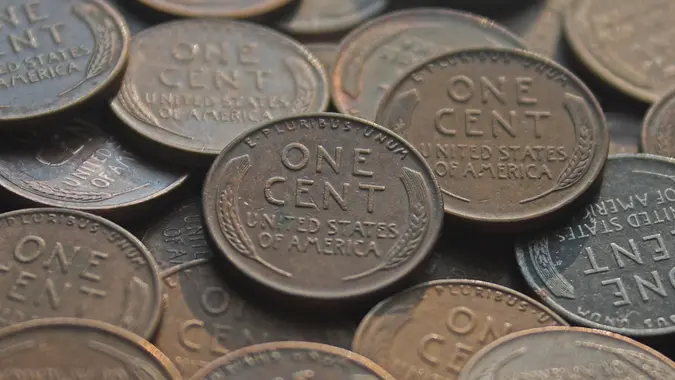Advertiser Disclosure
GOBankingRates works with many financial advertisers to showcase their products and services to our audiences. These brands compensate us to advertise their products in ads across our site. This compensation may impact how and where products appear on this site. We are not a comparison-tool and these offers do not represent all available deposit, investment, loan or credit products.
How Much You Need To Earn To Be in the Top 1% in Every State
 Written by
Heather Taylor
Written by
Heather Taylor
 Edited by
Chris Cluff
Edited by
Chris Cluff

Commitment to Our Readers
GOBankingRates' editorial team is committed to bringing you unbiased reviews and information. We use data-driven methodologies to evaluate financial products and services - our reviews and ratings are not influenced by advertisers. You can read more about our editorial guidelines and our products and services review methodology.

20 YearsHelping You Live Richer

Reviewed by Experts

Trusted by Millions of Readers
There are only three states where earning less than $500,000 annually means you are considered wealthy enough to be among the top 1% of said states.
GOBankingRates determined these earnings by reviewing IRS data from the 2022 tax season and isolating every state’s top 1% income threshold. From there, we used the Bureau of Labor Statistics CPI inflation calculator to find each figure in 2025 dollars.
See how much you would need to make to be in every state’s top 1% of earners.
Alabama
- Lower limit of the top 1% (2022 dollars): $491,737
- Lower limit of the top 1% (2025 dollars): $555,617
Alaska
- Lower limit of the top 1% (2022 dollars): $541,391
- Lower limit of the top 1% (2025 dollars): $611,721
Arizona
- Lower limit of the top 1% (2022 dollars): $592,062
- Lower limit of the top 1% (2025 dollars): $668,975
Arkansas
- Lower limit of the top 1% (2022 dollars): $478,036
- Lower limit of the top 1% (2025 dollars): $540,136
California
- Lower limit of the top 1% (2022 dollars): $835,930
- Lower limit of the top 1% (2025 dollars): $944,522
Colorado
- Lower limit of the top 1% (2022 dollars): $713,682
- Lower limit of the top 1% (2025 dollars): $806,393
Connecticut
- Lower limit of the top 1% (2022 dollars): $975,899
- Lower limit of the top 1% (2025 dollars): $1,102,674
Delaware
- Lower limit of the top 1% (2022 dollars): $534,189
- Lower limit of the top 1% (2025 dollars): $603,583
Florida
- Lower limit of the top 1% (2022 dollars): $793,446
- Lower limit of the top 1% (2025 dollars): $896,519
Georgia
- Lower limit of the top 1% (2022 dollars): $611,967
- Lower limit of the top 1% (2025 dollars): $691,465
Hawaii
- Lower limit of the top 1% (2022 dollars): $518,093
- Lower limit of the top 1% (2025 dollars): $585,396
Idaho
- Lower limit of the top 1% (2022 dollars): $579,669
- Lower limit of the top 1% (2025 dollars): $654,971
Illinois
- Lower limit of the top 1% (2022 dollars): $675,101
- Lower limit of the top 1% (2025 dollars): $762,800
Indiana
- Lower limit of the top 1% (2022 dollars): $490,566
- Lower limit of the top 1% (2025 dollars): $554,293
Iowa
- Lower limit of the top 1% (2022 dollars): $511,537
- Lower limit of the top 1% (2025 dollars): $577,988
Kansas
- Lower limit of the top 1% (2022 dollars): $563,148
- Lower limit of the top 1% (2025 dollars): $636,304
Kentucky
- Lower limit of the top 1% (2022 dollars): $458,204
- Lower limit of the top 1% (2025 dollars): $517,727
Louisiana
- Lower limit of the top 1% (2022 dollars): $508,840
- Lower limit of the top 1% (2025 dollars): $574,942
Maine
- Lower limit of the top 1% (2022 dollars): $508,666
- Lower limit of the top 1% (2025 dollars): $574,745
Maryland
- Lower limit of the top 1% (2022 dollars): $625,559
- Lower limit of the top 1% (2025 dollars): $706,823
Massachusetts
- Lower limit of the top 1% (2022 dollars): $891,118
- Lower limit of the top 1% (2025 dollars): $1,006,879
Michigan
- Lower limit of the top 1% (2022 dollars): $518,495
- Lower limit of the top 1% (2025 dollars): $585,850
Minnesota
- Lower limit of the top 1% (2022 dollars): $619,895
- Lower limit of the top 1% (2025 dollars): $700,423
Mississippi
- Lower limit of the top 1% (2022 dollars): $405,760
- Lower limit of the top 1% (2025 dollars): $458,471
Missouri
- Lower limit of the top 1% (2022 dollars): $516,151
- Lower limit of the top 1% (2025 dollars): $583,202
Montana
- Lower limit of the top 1% (2022 dollars): $606,435
- Lower limit of the top 1% (2025 dollars): $685,215
Nebraska
- Lower limit of the top 1% (2022 dollars): $557,565
- Lower limit of the top 1% (2025 dollars): $629,996
Nevada
- Lower limit of the top 1% (2022 dollars): $649,721
- Lower limit of the top 1% (2025 dollars): $734,124
New Hampshire
- Lower limit of the top 1% (2022 dollars): $678,953
- Lower limit of the top 1% (2025 dollars): $767,153
New Jersey
- Lower limit of the top 1% (2022 dollars): $831,947
- Lower limit of the top 1% (2025 dollars): $940,022
New Mexico
- Lower limit of the top 1% (2022 dollars): $416,987
- Lower limit of the top 1% (2025 dollars): $471,156
New York
- Lower limit of the top 1% (2022 dollars): $823,230
- Lower limit of the top 1% (2025 dollars): $930,173
North Carolina
- Lower limit of the top 1% (2022 dollars): $591,619
- Lower limit of the top 1% (2025 dollars): $668,474
North Dakota
- Lower limit of the top 1% (2022 dollars): $642,377
- Lower limit of the top 1% (2025 dollars): $725,825
Ohio
- Lower limit of the top 1% (2022 dollars): $508,470
- Lower limit of the top 1% (2025 dollars): $574,523
Oklahoma
- Lower limit of the top 1% (2022 dollars): $502,889
- Lower limit of the top 1% (2025 dollars): $568,217
Oregon
- Lower limit of the top 1% (2022 dollars): $556,741
- Lower limit of the top 1% (2025 dollars): $629,065
Pennsylvania
- Lower limit of the top 1% (2022 dollars): $605,333
- Lower limit of the top 1% (2025 dollars): $683,970
Rhode Island
- Lower limit of the top 1% (2022 dollars): $556,885
- Lower limit of the top 1% (2025 dollars): $629,227
South Carolina
- Lower limit of the top 1% (2022 dollars): $536,054
- Lower limit of the top 1% (2025 dollars): $605,691
South Dakota
- Lower limit of the top 1% (2022 dollars): $634,466
- Lower limit of the top 1% (2025 dollars): $716,887
Tennessee
- Lower limit of the top 1% (2022 dollars): $589,326
- Lower limit of the top 1% (2025 dollars): $665,883
Texas
- Lower limit of the top 1% (2022 dollars): $686,876
- Lower limit of the top 1% (2025 dollars): $776,105
Utah
- Lower limit of the top 1% (2022 dollars): $637,566
- Lower limit of the top 1% (2025 dollars): $720,390
Vermont
- Lower limit of the top 1% (2022 dollars): $538,786
- Lower limit of the top 1% (2025 dollars): $608,778
Virginia
- Lower limit of the top 1% (2022 dollars): $647,948
- Lower limit of the top 1% (2025 dollars): $732,120
Washington
- Lower limit of the top 1% (2022 dollars): $756,256
- Lower limit of the top 1% (2025 dollars): $854,498
West Virginia
- Lower limit of the top 1% (2022 dollars): $384,369
- Lower limit of the top 1% (2025 dollars): $434,301
Wisconsin
- Lower limit of the top 1% (2022 dollars): $523,231
- Lower limit of the top 1% (2025 dollars): $591,202
Wyoming
- Lower limit of the top 1% (2022 dollars): $712,186
- Lower limit of the top 1% (2025 dollars): $804,703
Methodology: GOBankingRates looked at Internal Revenue Service data from the 2022 tax season and found each state’s threshold for the top 1% of earners. Once these figures were isolated, GOBankingRates used the Bureau of Labor Statistics CPI inflation calculator to find each figure in 2025 dollars. All data was collected on and is up to date as of Feb. 27, 2025.
Share This Article:




You May Also Like



If the Top 10 Billionaires' Wealth Was Distributed Equally in America, How Much Money Would Each Person Get?
December 03, 2025
6 min Read



How To Make Extraordinary Wealth Buying a Surprising Business, According To Codie Sanchez
December 02, 2025
6 min Read

If Every American Earned the Median CEO Salary, How Much Richer Would the Country Be?
December 02, 2025
6 min Read

I'm a Career Expert: Here Are the Top Books I Recommend for People Interested in Growing Wealth
December 02, 2025
6 min Read

Check Your $2 Bills -- They Could Be Worth Big Bucks If They Feature These Rarities
December 01, 2025
6 min Read

How Rich People Respond to Financial Turbulence, According to Robert Kiyosaki
December 02, 2025
6 min Read
Make your money work for you
Get the latest news on investing, money, and more with our free newsletter.
By subscribing, you agree to our Terms of Use and Privacy Policy. Unsubscribe at any time.


Thanks!
You're now subscribed to our newsletter.
Check your inbox for more details.



Sending you timely financial stories that you can bank on.
Sign up for our daily newsletter for the latest financial news and trending topics.
For our full Privacy Policy, click here.
Looks like you're using an adblocker
Please disable your adblocker to enjoy the optimal web experience and access the quality content you appreciate from GOBankingRates.
- AdBlock / uBlock / Brave
- Click the ad blocker extension icon to the right of the address bar
- Disable on this site
- Refresh the page
- Firefox / Edge / DuckDuckGo
- Click on the icon to the left of the address bar
- Disable Tracking Protection
- Refresh the page
- Ghostery
- Click the blue ghost icon to the right of the address bar
- Disable Ad-Blocking, Anti-Tracking, and Never-Consent
- Refresh the page








